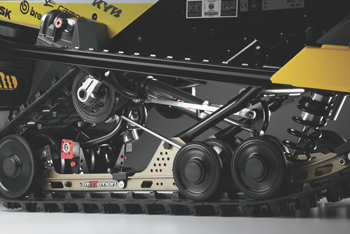 To make our 2005 F6 Firecat Sno Pro work better in those conditions, we brought it to Fett Brothers Performance in Frazee, Minnesota, to have Dale and Dennis Fett install their Ride Tech suspension Kit No. 2.
To make our 2005 F6 Firecat Sno Pro work better in those conditions, we brought it to Fett Brothers Performance in Frazee, Minnesota, to have Dale and Dennis Fett install their Ride Tech suspension Kit No. 2.
After they made the suspension mods, we were impressed by how much the sled improved. It cornered flatter and its suspensions handled bumps far better than the factory setup. Our F6 Sno Pro suddenly became the staff’s favorite machine.
Pre-Suspension Mod Impressions
We put about 600 clicks on the odometer of our F6 Sno Pro before we brought it to the central-Minnesota shop in February. We also fitted its 13.5- by 128- by 1.375-inch track with 106 Fast-Trac studs and bolted 7.5-inch carbides on the skis.
As expected, the factory suspension calibrations were stiff. Arctic Cat markets Sno Pro models toward aggressive riders who seek moguls rather turn around with their tail between their legs when they see a rough patch of trail.
Most riders weren’t able to bottom the rear suspension and no rider was able to bottom the FLOAT-equipped front suspension.
In relatively smooth conditions, with some occasional chop and a few minor moguls and holes, the sled’s suspensions handled the bumps and chunks fine. In really smooth conditions, the inside ski lifted.
When coming into irregular 1- to 2-foot bumps at speed, the sled usually bounced into the air at awkward angles. Clean, straight bumps, such as small driveway approaches, pitched the nose of the machine toward the sky.
This bouncing action seemed to be caused by the fact that the suspensions were set up so stiff that the nearly 14 inches of rear travel and 9 inches up front weren’t being used because calibrations weren’t progressive. We knew this sled could be better.
The goal of the Fett Brothers Performance kit is to reduce ski lift and front-end push of F chassis-based sleds. The kit was also engineered to provide smoother performance on washboard trails and to make the suspensions more capable of absorbing hard hits without bouncing off of big moguls.
Significant changes were made to the front and rear suspensions of our F6 Firecat Sno Pro. Up front, 1-inch spacers were installed in the FLOAT shocks and the valve stack was changed. Preload was increased from the stock setting of 50 to 55 psi.
The spacers lowered the front end 1 inch. This sacrificed an inch of suspension travel, but the new valve stack allowed better use of the remaining travel, so our sled actually gained more than it lost. The spacers lowered the sled’s center of gravity, which helped it corner flatter.
In the rear, both shocks were revalved and “top-secret” modifications were made to the rear shock’s internal floating piston to alter oil flow inside the shock. All we can say is that the modification involved a wire-feed welder and a carefully selected drill bit.
Low-speed valving was adjusted to improve the suspension’s ability to absorb washboard bumps, but the high-speed valve code was made “quite a bit stiffer,” according to Dennis Fett.
On reinstallation, the front track shock’s mount location was moved and thinner rear scissor stop blocks were installed. The new blocks allowed the skidframe to couple later in its arc of travel to help keep the skis on the ground during acceleration and when smashing through bumps.
The front shock’s new mount location was also meant to improve cornering ability. A stiffer spring was installed on that shock because its new position softened its compression ratio.
At the factory, Sno Pro skidframes are bolted low in the tunnel. This increases ground clearance, but offers no performance gain. It looks cool, though. Because performance matters more than appearance, Fett Brothers Performance bolted the suspension higher in the tunnel where standard Firecat suspensions mount.
The mount holes were already punched in the tunnel. This new location reduced the track’s approach angle, which reduced rolling resistance and probably increased the machine’s top-end speed by several miles per hour. Once everything was bolted in place, it was time for a test ride.
It didn’t take long for us to realize how much the performance of our F6 Firecat Sno Pro had improved. Our first ride was down a state highway ditch that had sections of small chop and small road approaches.
When we came into the chop for the first time since making the changes, we prepared for the Firecat’s ski tips to bounce precariously into the air, but they didn’t — not then or any time after that.
The sled’s suspensions absorbed the bumps, which allowed the machine to stay flat and on course. When the machine went airborne, it flew flat, straight and in control.
Trail rides throughout the rest of the season showed that our F6 Sno Pro’s handling characteristics improved significantly, too. The sled went from being tippy and unsettled through the woods to having an on-rails, stuck-to-the-trail-like-Velcro feel.
The new geometry from the reworked skidframe kept the front end down and the sled in control. The sled felt tighter, too. After going airborne off a mogul or road approach, the sled always set down without bouncing.
Do you know a Firecat that would benefit from some suspension mods? Fett Brothers Performance says owners just need to send in their shocks along with their weight, riding style and specific year and model of the machine.
The company will service the shocks and return them with new parts, as needed, and setup instructions.
Setups vary. Call for specific pricing and turnaround time.

